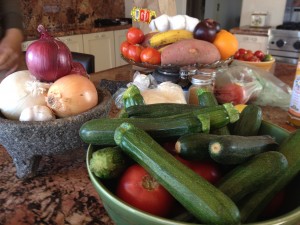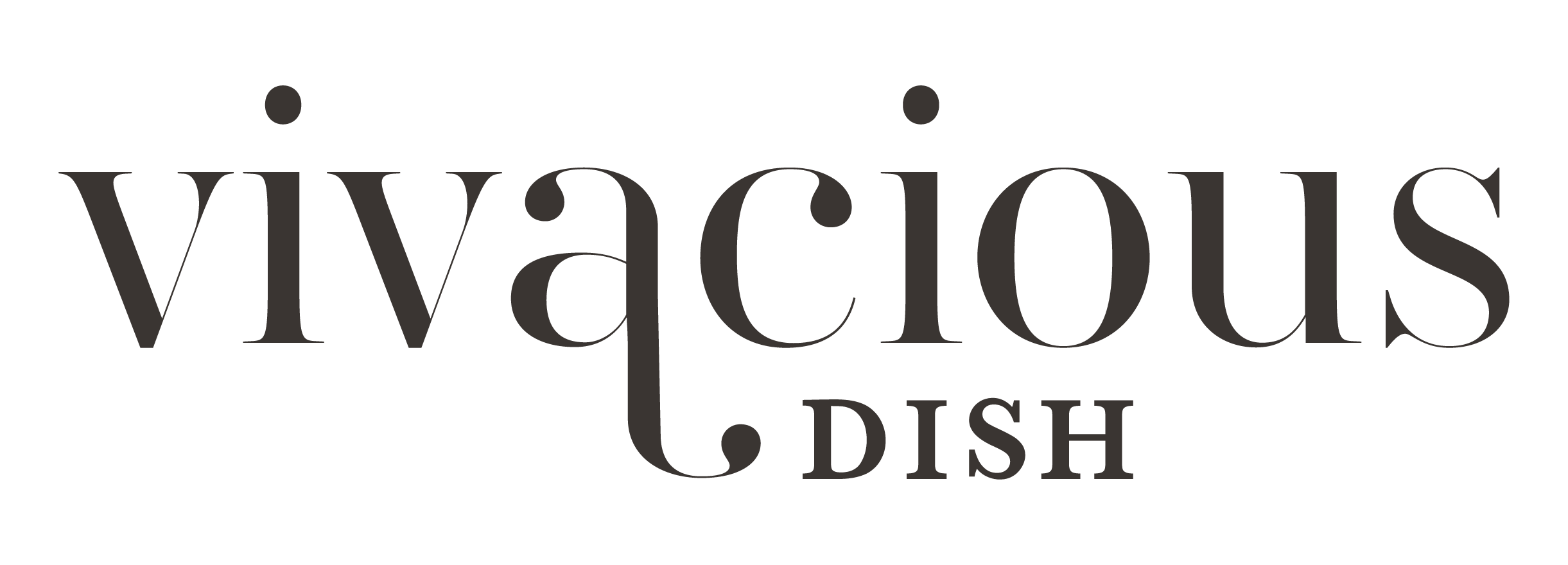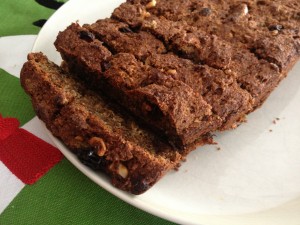Mastering Recipe Modifications
One of the things I love most about living a nutrient dense lifestyle (besides the fact that it makes me feel great) is being creative in the kitchen. When it comes to recreating comfort foods without grains or dairy, the key is substitution. Baking is especially tricky, since it’s largely about chemistry and correct proportions of liquid to dry ingredients, so changing things up can result in dry and crumbly cakes or flat and lifeless breads. That’s not to say that modifying ingredients is a bad idea. I’m still an avid supporter.
Baking is especially tricky, since it’s largely about chemistry and correct proportions of liquid to dry ingredients, so changing things up can result in dry and crumbly cakes or flat and lifeless breads. That’s not to say that modifying ingredients is a bad idea. I’m still an avid supporter.
Just be prepared to have things not turn out perfectly the first go-around. Cooking, like life, is a process of trying new things, making mistakes, applying what you’ve learned, and doing it better the next time. Time spent in the kitchen is definitely therapeutic for my perfectionist tendencies. And when the hard work pays off, it feels (and tastes) so good.
After all the trial and error that goes on behind the scenes (I couldn’t tell you the number of times I’ve burnt things or had them taste just plain awful), I relish opportunities to serve a meal and have my guests rave about the entire experience. After they’ve finished licking the plate, I tell them that everything was grain, gluten, dairy and sugar free. 98.7% of the time, they respond with a look of amazement and a comment along the lines of, “Wow, that was so delicious, and I don’t feel bloated, tired, or heavy at all.”
Exactly. Food should ALWAYS satisfy, energize and nourish. Plain and simple. Any other physiological post-meal response (tired, sleepy, grumpy, headache, bloated, “food coma”) means that you are eating something that is not good for you and your body, and therefore you are not maximizing your nutrient absorption and energy conversion. The good news is that you CAN eat foods that taste great and make you feel even better.
So what do you do when you are craving a comfort food but want to feel great after eating it? Here’s my four-step approach to modifying any recipe to maximize flavor and health benefits:
1. Google search your recipe of choice, followed by “Paleo,” “gluten free,” “vegan,” “sugar free” and/or “dairy free.” Once you’ve read through a couple of different modified recipes, you’ll start to get a feel for which ingredients you can use as substitutes for others. The great thing about the world we live in is that someone has already done what you are trying to do, and most likely, they’ve posted something about it online too. Another useful search tag is “substitutes for _______” (insert whatever food you are sensitive to, or don’t have in your kitchen).
2. Experiment based on what others have already tried and your own health profile. I'm talking here about bio-individualism, the fact that everyone has her own unique profile of foods that are best for her body. Ask yourself what foods you know make you feel weird, and work to replace them with foods that make you feel well instead. Does eating onions make you tired? Try replacing them with celery and extra black pepper instead. Do potatoes make your stomach bloated? Sweet potatoes or cauliflower are a great substitute. A great approach to healthy eating is to only stock your kitchen with the foods that you know make you feel good, and then figure out ways to use these items to make the food you are craving. I’ve created some of my best recipes on days when I was nearly out of food and had to raid the last of my produce and pantry to pull a meal together.
3. Keep in mind that cooking is a combination of chemistry, texture, flavor and intention. Unless you’re excited about food science, the chemistry may be something to put on the back burner for now, especially if you’re new to the practice of recipe modifications. Instead, focus on replacing ingredients with items that have similar textures (crunchy, grainy, smooth) and flavors (spicy, sweet, smoky), and do your best to keep the proportions of wet to dry to oily as similar to the original recipes as possible. Combined with the intention to prepare a meal that satisfies the taste buds and nourishes your body, you’re well on your way to mastering the practice of recipe modification. And if nothing else, you’ll feel great knowing that you’re investing time and energy in improving your health, even when your recipe isn’t dinner party-worthy the first go around.
4. Let go of fear and ego (a good practice in general), and try it out. To reduce anxiety about what people might think of your cooking, make the recipe for yourself the first time, and do it when you aren’t in a hurry or when hungry people aren’t waiting for the meal. If you are cooking for your partner or loved ones, let them know in advance that the recipe is experimental. If the outcome is truly inedible, my best advice is just to throw it out, appreciate the learning opportunity, and swing by your favorite health food joint for some takeout instead.
Following these four simple steps, I now present to you a case study in comfort food recipe modification.
Step 1: It’s Sunday morning, I am out of eggs, but I am seriously craving a moist and chewy zucchini bread. I Google search “vegan” and “egg free” bread recipes, and find a few different options that use ground chia seeds in water as an egg substitute. I have used ground flax seeds in water to make a vegan egg substitute before, but the chia seeds sound like an interesting choice. Alright, let’s try that.
Step 2: Keeping with my grain free, sugar free, and dairy free lifestyle, now I need a recipe that also met these criteria. I search further for Paleo bread, and come across The Detoxinista’s awesome almond flour banana bread (absolutely worth trying; it’s hands down the most chewy and flavorful banana bread I’ve ever tried, Paleo or otherwise) that already included the chia seed egg substitution. Perfect! No bananas in my kitchen this morning, but zucchini should do the trick.
Step 3: Zucchini is drier than bananas, and lacks the same sweetness, so I will need to adjust the amount of wet ingredients and honey in the recipe to accommodate. In general, I try to minimize my intake of sweeteners*, raw honey included, because my delicate hormone balance is easily offset by sharp spikes in blood sugar. In this case, I am using unsweetened applesauce to help round out the zucchini for banana substitution. I've been getting stomach aches after eating almonds recently, so I'm using hazelnut meal instead. And I’m a fan of a little crunch in my breads, so I am adding ½ cup chopped walnuts and 1/2 cup raisins as well. Cranberries or dark chocolate chips would also be delicious, if you’re feeling adventurous. I love spices, so I’m adding nutmeg, cloves and allspice too.
Step 4: Let’s go for it! Below is the comparison between the original recipe and my modified version, with additions.
Get cooking now with the final grain free zucchini bread recipe, or read on for the full list of modifications.
If you have questions about additional substitutions or want to share your own modified recipes, post a comment below or send me an email. I would love to hear from you!
| Original Recipe | Modified Recipe |
| 3 cups almond meal | 3 cups hazelnut meal |
| 2 tsp baking soda | 2 tsp baking soda |
| ½ tsp sea salt | ½ tsp sea salt |
| ¼ cup coconut oil | ¼ cup coconut oil |
| ¼ cup + 2 Tbsp ground chia seeds | ¼ cup + 2 Tbsp ground chia seeds |
| ¾ cup water | ¾ cup water |
| 2 very ripe bananas, mashed | ¾ cup grated zucchini, squeezed with a paper towel to drain |
| 1 Tbsp vanilla extract | 1 Tbsp vanilla extract |
| ¼ cup raw honey (or maple syrup) | ¼ cup raw honey (or ¼ tsp pure stevia powder) |
| 1 tsp cinnamon | 1 tsp cinnamon |
| ¼ cup unsweetened apple sauce | |
| ½ tsp nutmeg | |
| ¼ tsp cloves | |
| ¼ tsp allspice | |
| ½ cup chopped walnuts | |
| ½ cup raisins |
*Note: I don’t eat synthetic sweeteners (aspartame, xylitol, erythritol), but I am comfortable using pure stevia as a substitute to sugar or honey (here’s a helpful stevia conversion chart). I am cautious of the stevia I choose to use because many brands, like Stevia in the Raw, include maltodextrin, which is most often derived from corn or another starch. I prefer the Body Ecology brand because it has no additional additives and a very clean flavor with no aftertaste. Keep in mind that as a general rule, most strict Paleo dieters only allow the addition of raw honey on rare occasion, and many following this lifestyle find stevia to be a poor choice since it is highly refined to turn this sweet leaf into a fine white powder. Again, it really just comes down to finding the balance that works best for you. When I do use stevia in either a liquid or powdered form in my recipes, I will include the correct measurements of honey or maple syrup as well.

